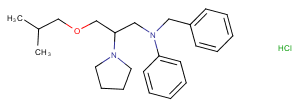Bepridil hydrochloride
| Code | Size | Price |
|---|
| TAR-T5391-5mg | 5mg | £103.00 | |||||||||||||||||||||||||||||||||||||||||||||||||||||||||||||||||||||||||||||||||||||||||||||||||
| Special offer! Add £1 to your order to get a TargetMol CCK-8 Kit. Read more here. | |||||||||||||||||||||||||||||||||||||||||||||||||||||||||||||||||||||||||||||||||||||||||||||||||||
Quantity:
| TAR-T5391-1mL | 1 mL * 10 mM (in DMSO) | £107.00 | |||||||||||||||||||||||||||||||||||||||||||||||||||||||||||||||||||||||||||||||||||||||||||||||||
| Special offer! Add £1 to your order to get a TargetMol CCK-8 Kit. Read more here. | |||||||||||||||||||||||||||||||||||||||||||||||||||||||||||||||||||||||||||||||||||||||||||||||||||
Quantity:
| TAR-T5391-10mg | 10mg | £114.00 | |||||||||||||||||||||||||||||||||||||||||||||||||||||||||||||||||||||||||||||||||||||||||||||||||
| Special offer! Add £1 to your order to get a TargetMol CCK-8 Kit. Read more here. | |||||||||||||||||||||||||||||||||||||||||||||||||||||||||||||||||||||||||||||||||||||||||||||||||||
Quantity:
| TAR-T5391-25mg | 25mg | £149.00 | |||||||||||||||||||||||||||||||||||||||||||||||||||||||||||||||||||||||||||||||||||||||||||||||||
| Special offer! Add £1 to your order to get a TargetMol CCK-8 Kit. Read more here. | |||||||||||||||||||||||||||||||||||||||||||||||||||||||||||||||||||||||||||||||||||||||||||||||||||
Quantity:
| TAR-T5391-50mg | 50mg | £179.00 | |||||||||||||||||||||||||||||||||||||||||||||||||||||||||||||||||||||||||||||||||||||||||||||||||
| Special offer! Add £1 to your order to get a TargetMol CCK-8 Kit. Read more here. | |||||||||||||||||||||||||||||||||||||||||||||||||||||||||||||||||||||||||||||||||||||||||||||||||||
Quantity:
| TAR-T5391-100mg | 100mg | £222.00 | |||||||||||||||||||||||||||||||||||||||||||||||||||||||||||||||||||||||||||||||||||||||||||||||||
| Special offer! Add £1 to your order to get a TargetMol CCK-8 Kit. Read more here. | |||||||||||||||||||||||||||||||||||||||||||||||||||||||||||||||||||||||||||||||||||||||||||||||||||
Quantity:
Prices exclude any Taxes / VAT
Overview
Regulatory Status: RUO
Shipping:
cool pack
Storage:
-20℃
Images
Documents
Further Information
Bioactivity:
Bepridil is a calcium channel blocker and also inhibits Na+/Ca2+ exchange (NCX), sodium channels and cardiac sarcolemmal KATP channels.
CAS:
68099-86-5
Formula:
C24H35ClN2O
Molecular Weight:
403.01
Pathway:
Metabolism; Membrane transporter/Ion channel
Purity:
0.9945
SMILES:
Cl.CC(C)COCC(CN(Cc1ccccc1)c1ccccc1)N1CCCC1
Target:
Calcium Channel
References
Flaim SF, et al. Effects of bepridil hydrochloride on cardiocirculatory dynamics, coronary vascular resistance, and cardiac output distribution in normal, conscious rats. J Cardiovasc Pharmacol. 1988 Mar;11(3):363-72.
Li Y, et al. Bepridil blunts the shortening of action potential duration caused by metabolic inhibition via blockade of ATP-sensitive K(+) channels and Na(+)-activated K(+) channels. J Pharmacol Exp Ther. 1999 Nov;291(2):562-8.
Qiu M, Li Z, Chen Y, et al. Tolcapone Potently Inhibits Seminal Amyloid Fibrils Formation and Blocks Entry of Ebola Pseudoviruses. Frontiers in Microbiology. 2020, 11: 504.
Qiu M, Li Z, Chen Y, et al. Tolcapone Potently Inhibits Seminal Amyloid Fibrils Formation and Blocks Entry of Ebola Pseudoviruses. Frontiers in Microbiology. 2020, 11: 504



